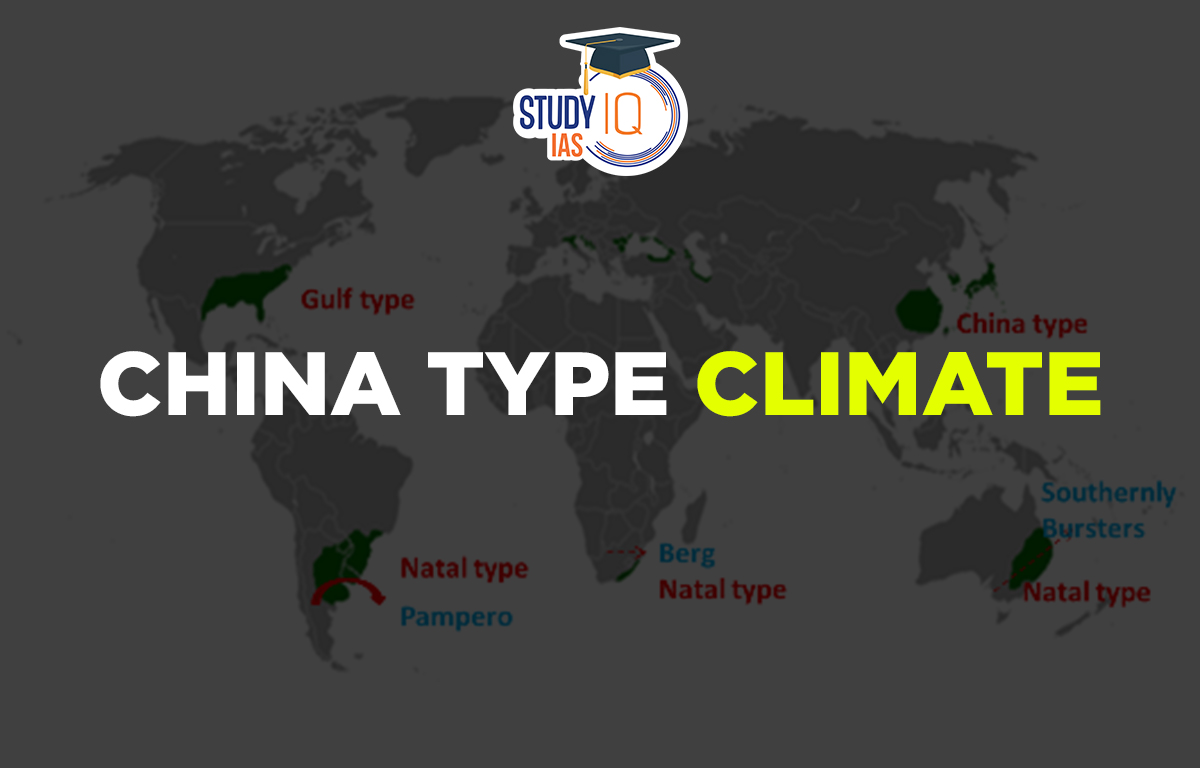Table of Contents
China Type Climate
The China-type climate is found on the eastern edges of continents in warm temperate areas just outside the tropics. It has very hot summers and very cold winters. This climate is common throughout most of China. Southern Japan has a climate characterized by dry seasons and wet monsoons, which cause significant temperature changes between winter and summer. One of the most important geography subjects’ topics is this. Thus, a thorough comprehension of this subject is essential.
The UPSC exam’s syllabus includes a crucial topic Warm Temperate Eastern Marginal Climates commonly known as China Type Climate.
Read More: Climatology
Warm Temperate Eastern Marginal Climates
Warm Temperate Eastern Marginal Climate is divided into three types namely China Type Climate, Gulf-type climate and Natal Type Climate.
1. China-Type Climate
Most parts of China have temperate monsoons or China-type climates. The climate is also found in the southern regions of Japan.
2. Gulf-Type Climate
It is found in the Southeastern USA, bordered by the Gulf of Mexico. It is found in the area where air flows from the Atlantic Ocean, cooler than the continental heat in summer.
3. Natal Type Climate
It is found in New South Wales (Australia), Natal (South Africa), and Parana-Paraguay-Uruguay Basin (South America). The Natal type differs from the temperate monsoons or the China type in that it receives rainfall from coastal winds throughout the year.
Read More: Equatorial Climate Region
China Type Climate Distribution
Found between latitudes 20 ° and 35 ° N and S (warmer temperate latitudes outside the tropics). It is found on the east coast in both hemispheres. China’s climate is characterised by dry seasons and wet monsoons, which cause significant temperature changes between winter and summer. The northern and central regions of China as well as southern Japan have climates similar to those of China.
Read More: Tropical Climate
China Type Climate Characteristics
The China Type Climate has hot, humid summers and cold, dry winters (though winters can also be humid in some areas). This climate faces big temperature changes between winter and summer. In winter, cold northern winds come from high-latitude areas, while warm, humid southern breezes come from the sea in summer. Monthly temperatures can vary from 4 to 25 degrees Celsius, influenced by coastal conditions. Sometimes, icy air from inland areas can cause temperatures to drop to freezing, but frosts are rare in cooler regions.
1. Temperature
The average monthly temperature varies between 4 C and 25 C and is strongly modified by the sea effect. Sometimes, cold air from inland areas can drop temperatures to freezing. While frosts are uncommon, they can happen in colder regions.
2. Rainfall
Rainfall is Moderate to high, 60 cm to 150 cm. Rainfall is distributed evenly throughout the year. Precipitation comes from convective sources or orographic rain in summer or depressions in long showers in winter. In summer, areas are affected by moist ocean airflow from subtropical anticyclonic cells. Local storms, e.g., Typhoons (tropical cyclones), and even hurricanes, happen.
3. Precipitation
The amount of rain is average, falling between 60 and 150 millimeters. This is adequate for all agricultural requirements and supports a wide variety of crops. Areas with a high population density are impacted by this climate. Throughout the year, rainfall follows a pattern that is largely predictable. In winter, rain comes from long-lasting weather systems, while in summer rain is caused by rising warm air or hills. During summer, subtropical high-pressure areas bring moist air to the region. Tropical cyclones, like typhoons and hurricanes, often affect the area.
Read More: Steppe Climate
China Type Climate in Summer
In the summer, a low-pressure zone is produced by intense internal temperature (Tibet, the desert region). This zone draws tropical Pacific air (South-East Monsoon). Unlike in India, the monsoon in this region does not “burst” or “pour” as much. Instead, typhoons usually form in late summer, from July to September.
Read More: Desert Climate
China Type Climate in Winter
In winter, strong pressure over Siberia causes the very cold and dry North-West Monsoon to flow out from the continent as the polar airstream. The windward slopes have a lot of snow, but there isn’t much rain. Another climatic factor associated with the southern China climate is typhoons.
China Type Climate Natural Vegetation
It has a lot of vegetation. The lowlands are home to both evergreen forests and deciduous trees (hardwoods). In the highlands, you’ll find various conifers, like pine and cypress, which are important softwoods. The forests of China and southern Japan have great economic value and include oak, camphor, etc. In southeastern Brazil, eastern Paraguay, and northeastern Argentina, there are Parana pine and quebracho (an axe breaker, very hardwood). Used for tanning). Eucalyptus forests are found in eastern Australia. In Natal, palm trees thrive. The Gulf states of the United States have inland deciduous forests.
Read More: Natural Vegetation of India
Timber
The forests in southern Japan and China, which contain oak, camphor, and other trees, are also very economically valuable. In northeastern Argentina, eastern Paraguay, and south-eastern Brazil, you can find quebracho and parana pine trees (ax-breaker, an extremely hardwood used for tanning). Eastern Australia contains eucalyptus woodlands. In Natal, palm trees are found. The Gulf states of the United States of America have covered in lowland deciduous forests.
China Type Climate Agriculture & Farming
China produces a third of the world’s rice, thanks to its large population and favorable growing conditions. Monsoon China has the perfect environment for rice farming, with flat lowlands, fertile soil, warm temperatures, and enough rainfall. When flatlands are not enough, farmers grow rice on terraced hillsides. In contrast, the Gulf states of the USA are covered in lowland deciduous forests.
1. Corn
The crop thrives in the muggy weather, scorching summer days, and frequent downpours. Corn is grown across the Midwest, especially south of the Great Lakes and from the Gulf Coast through Nebraska, Iowa, Indiana, and Ohio. This region produces over 50% of the world’s corn, but only 3% is exported. Most corn is used to feed livestock, particularly cattle and pigs. These fattened animals are then sent to meat processing plants in Chicago and Cincinnati to be turned into “corned beef.”
2. Cotton
Cotton is the most profitable cash crop in the Gulf states. The warm, humid climate is perfect for its growth, with a long growing season of about 200 frost-free days, allowing the crop to mature in six months. However, heavy rainfall in some Gulf areas can affect cotton quality, leading those regions to focus more on citrus crops, sugar cane, and market gardens, like in Florida. Today, commercial cotton farming is limited to the best areas, such as the Mississippi flood plains and Atlantic coastlands. The biggest threat to cotton in the Cotton Belt is the boll weevil, a pest that spreads quickly.
3. Tobacco
Tobacco is America’s original crop, with Virginian tobacco being particularly famous. The warm, humid climate and well-drained soils of the Gulf states make it easy to grow tobacco in several eastern states. These states produce over half of the tobacco used in international trade.
Read More: Savanna Climate
China Type Climate Life and Economy
The warm temperate eastern border is the most productive part of the latitudes. In addition to the widespread cultivation of maize and cotton, fruits and tobacco are also grown on the corn and cotton belts in the United States. Rice, tea, and mulberries are widely grown in monsoon China. Other products of economic importance have been found elsewhere, e.g., Sugarcane sugar in Natal, coffee and corn in South America, and dairy in New South Wales and Victoria.
China Type Climate UPSC
The climate in China is one of the important climates since it impacts climatological parameters both individually and collectively. They also make a significant contribution to the environment. They are crucial in determining the direction of the country’s economy. It grants definite seasonal temperature changes.


 Role of Teachers in Educations, Student ...
Role of Teachers in Educations, Student ...
 India's achievements after 75 years of I...
India's achievements after 75 years of I...
 Bal Gangadhar Tilak Biography, Achieveme...
Bal Gangadhar Tilak Biography, Achieveme...

























